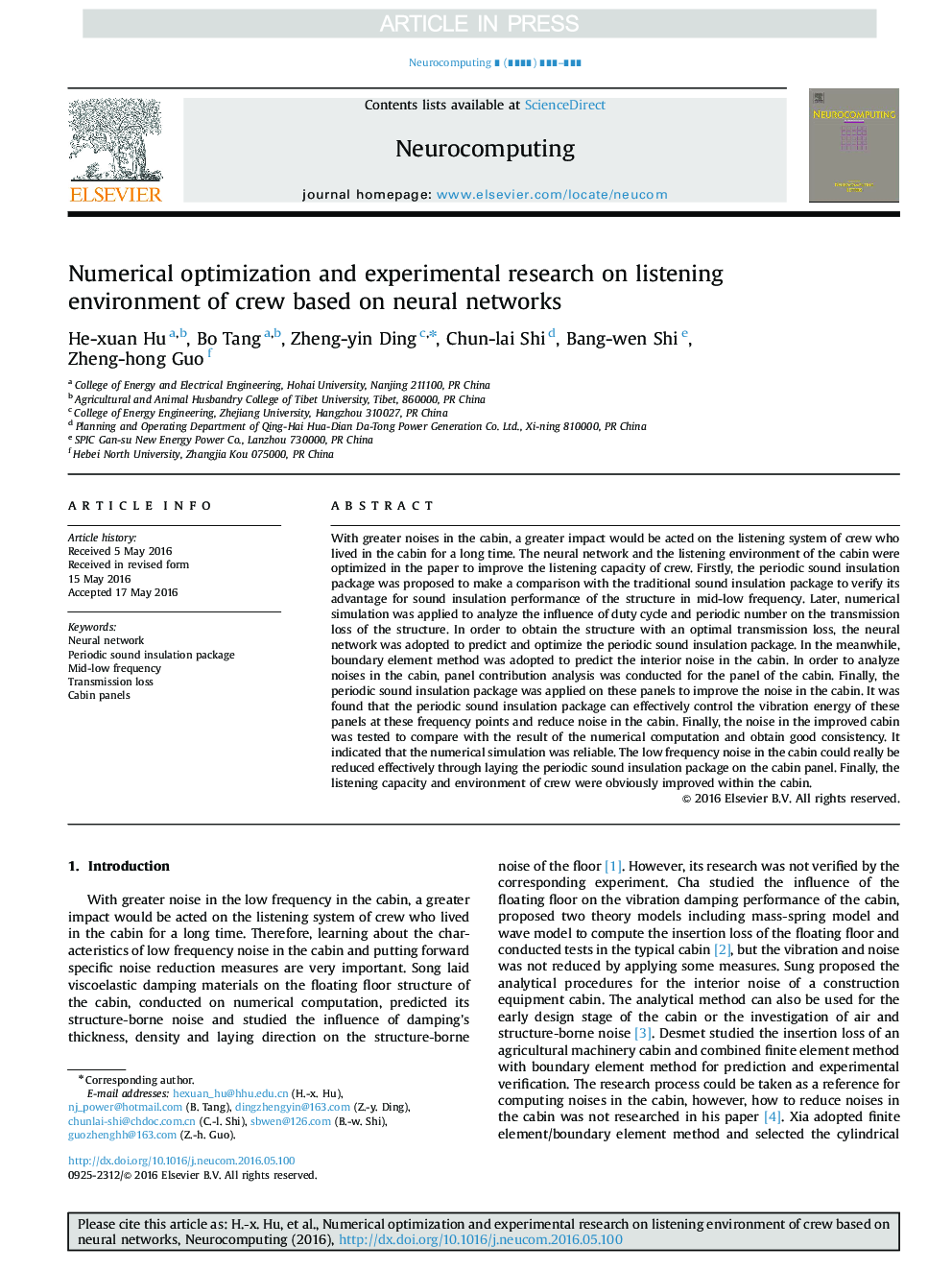| کد مقاله | کد نشریه | سال انتشار | مقاله انگلیسی | نسخه تمام متن |
|---|---|---|---|---|
| 4948108 | 1439607 | 2017 | 10 صفحه PDF | دانلود رایگان |
عنوان انگلیسی مقاله ISI
Numerical optimization and experimental research on listening environment of crew based on neural networks
ترجمه فارسی عنوان
بهینه سازی عددی و تحقیق تجربی بر روی محیط گوش دادن خدمه مبتنی بر شبکه عصبی
دانلود مقاله + سفارش ترجمه
دانلود مقاله ISI انگلیسی
رایگان برای ایرانیان
کلمات کلیدی
شبکه عصبی، بسته بندی عایق صدا دوره ای، فرکانس متوسط، از دست دادن انتقال، پنل های کابین
ترجمه چکیده
با صدای بیشتر در کابین، تأثیر بیشتر بر روی سیستم شنوایی خدمهی که در مدت زمان طولانی در کابین زندگی می کردند عمل می کرد. شبکه عصبی و محیط گوش دادن به کابین در این مقاله بهینه شده است تا ظرفیت گوش دادن خدمه را بهبود بخشد. اولا، بسته بندی عایق صدا دوره ای برای مقایسۀ با بسته بندی عایق صدا سنتی پیشنهاد شد تا مزیت آن را برای عملکرد عایق صدا در ساختار فرکانس میانه پایین بررسی کند. بعدها، شبیه سازی عددی برای بررسی تاثیر چرخه کار و تعداد دوره ای بر انتقال از دست دادن ساختار اعمال شد. برای به دست آوردن ساختار با از دست دادن انتقال مطلوب، شبکه عصبی برای پیش بینی و بهینه سازی بسته پانل صدای دوره ای تصویب شد. در عین حال، روش المان مرزی برای پیش بینی سر و صدایی داخلی در کابین به کار گرفته شد. برای تجزیه و تحلیل صدا در داخل کابین، تجزیه و تحلیل کمک های پنل برای پنل کابین انجام شد. در نهایت، بسته بندی عایق صدا دوره ای بر روی این پانل ها برای بهبود سر و صدا در کابین اعمال شد. مشخص شد که بسته بندی عایق صدا دوره ای می تواند به طور موثر انرژی ارتعاش این پانل ها را در این نقاط فرکانس کنترل و سر و صدا در کابین را کاهش دهد. در نهایت، سر و صدا در کابین بهبود یافته به مقایسه با نتیجه محاسبات عددی آزمایش شد و به دست آوردن هماهنگی خوب. این نشان داد که شبیه سازی عددی قابل اعتماد است. نویز فرکانس پایین در داخل کابین واقعا می تواند به طور مؤثر از طریق قرار دادن بسته بندی عایق صدا دوره ای در پنل کابین کاهش یابد. در نهایت، ظرفیت گوش دادن و محیط خدمه به وضوح در داخل کابین بهبود یافت.
موضوعات مرتبط
مهندسی و علوم پایه
مهندسی کامپیوتر
هوش مصنوعی
چکیده انگلیسی
With greater noises in the cabin, a greater impact would be acted on the listening system of crew who lived in the cabin for a long time. The neural network and the listening environment of the cabin were optimized in the paper to improve the listening capacity of crew. Firstly, the periodic sound insulation package was proposed to make a comparison with the traditional sound insulation package to verify its advantage for sound insulation performance of the structure in mid-low frequency. Later, numerical simulation was applied to analyze the influence of duty cycle and periodic number on the transmission loss of the structure. In order to obtain the structure with an optimal transmission loss, the neural network was adopted to predict and optimize the periodic sound insulation package. In the meanwhile, boundary element method was adopted to predict the interior noise in the cabin. In order to analyze noises in the cabin, panel contribution analysis was conducted for the panel of the cabin. Finally, the periodic sound insulation package was applied on these panels to improve the noise in the cabin. It was found that the periodic sound insulation package can effectively control the vibration energy of these panels at these frequency points and reduce noise in the cabin. Finally, the noise in the improved cabin was tested to compare with the result of the numerical computation and obtain good consistency. It indicated that the numerical simulation was reliable. The low frequency noise in the cabin could really be reduced effectively through laying the periodic sound insulation package on the cabin panel. Finally, the listening capacity and environment of crew were obviously improved within the cabin.
ناشر
Database: Elsevier - ScienceDirect (ساینس دایرکت)
Journal: Neurocomputing - Volume 220, 12 January 2017, Pages 244-253
Journal: Neurocomputing - Volume 220, 12 January 2017, Pages 244-253
نویسندگان
He-xuan Hu, Bo Tang, Zheng-yin Ding, Chun-lai Shi, Bang-wen Shi, Zheng-hong Guo,
